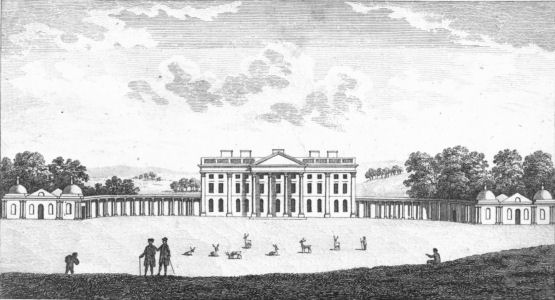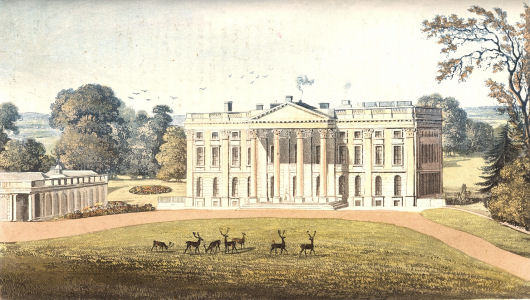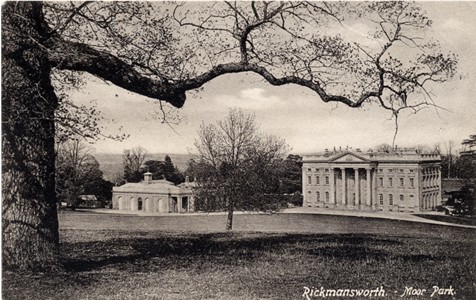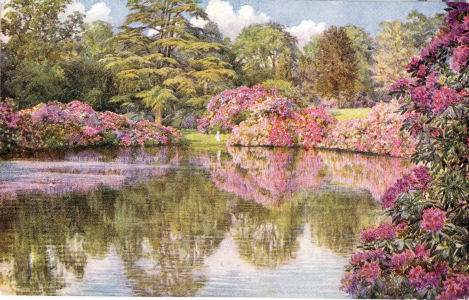|
Moor Park formerly in Rickmansworth |
The following description comes from Guide to Hertfordshire, by An Old Inhabitant (1880)
 |
|
|
Moor Park near Rickmansworth, in Hertfordshire The Seat of the Late Lord Anson from A New Display of the Beauties of England, 1773-4 |
In close proximity to the Town of Rickmansworth, is the celebrated MOOR PARK. The Mansion is about half a mile from the entrance. Moor Park is historically famous, from its having been possessed by persons who form conspicuous figures in our history. It was originally held for many years under the Abbots of St. Alban's. Having come into the possession of Edward IV., he granted it to Neville, Archbishop of York, brother to the King-making Earl of Warwick; after the battle of Barnet, and the death of the great Earl, the Archbishop was kept in a sort of honourable custody, and at last was deprived of his estates; he died in 1476, it is said, of a broken heart. It then reverted to the Crown, and Henry VII. granted it to the Earl of Oxford. For some time it was in the possession of Cardinal Wolsey; after his disgrace, it passed through several possessors, until it came to Robert Cary, Earl of Monmouth, third son of Lord Hunsdon, who with his son lies buried in Rickmansworth Church. After some years it passed to Thomas Earl of Upper Ossory, who was summoned to Parliament by the title of Baron Butler, of Moor Park (a title recently claimed and obtained, by the present Earl Cowper). It was afterwards sold to the unfortunate Duke of Monmouth, who settled it on his wife, the daughter of the Earl of Buccleugh; she sold it to a rich citizen, Benjamin Hoskins Styles Esq., who laid out vast sums upon the Park and Mansion, as did also Lord Anson, the great circumnavigator, who afterwards purchased it and resided here.
 |
|
|
Moor Park The Seat of Robert Williams, Esq No 27 of R Akermann's Repository of Arts &c, Pub, March 1, 1825 |
It is now in the possession of Lord Ebury. The House is a magnificent structure, with a grand portico of the Corinthian order, and a richly embellished pediment. The Duke of Monmouth built it of brick; and B. H. Styles, Esq., who had amassed a great fortune by the notorious South Sea scheme, new cased and fronted it with Portland stone, erected the magnificent portico, and added two wings to .it; he expended altogether upon the place £15,000, it is said. Lord Anson and other possessors also spent immense sums on the house and grounds; and M.P. Rous (into whose hands it at length came) pulled down the wings, for the purpose of disposing of the materials, as a matter of expediency, having become reduced in circumstances. By this means, the chapel, which was in one of the wings, was levelled with the ground, and a vault containing the bodies of Mr. Styles and his wife, who had been interred in it, was deprived of its external surroundings, and is now under a grass plot, near the western angle of the house. The House is situated in a hollow glade, and the south front has but a circumscribed view. The north front was originally in a similar position, but Mr. Styles cut through a hill which intercepted the view in that direction, at a cost of more than £5,000; for this he was satirized by Pope in his Moral Essays, where he describes the act thus :-
"Or cut wide views through mountains to the plain,
You'll wish your hill a sheltered seat again."
 |
|
|
Rickmansworth, Moor Park Also known published by E. S. Brown, Rickmansworth, and posted in 1907. |
In a note Pope remarks, "This was done in Hertfordshire by a wealthy citizen, by which means, merely to overlook a dead plain, he let in the north wind upon his house and pasture, which were before adorned and defended by beautiful woods."
In this Pope sacrifices truth to satire, for the view is now beautiful as well as extensive, and exhibits almost the perfection of rural beauty, with two rivers and the Grand Junction Canal running through a valley, luxuriant in verdure, and with noble seats, and pleasant villas and farms, and the towns, of Watford and Rickmansworth included in it. The interior of this Mansion is most magnificent and ornate. Sir James Thornhill painted the saloon, and is said to have received £3,500 for painting the ceiling alone, after Guido. The hall and all the principal apartments are embellished in the most gorgeous style, and are further adorned with a splendid collection of pictures. The offices are not attached to the house, but form a handsome elevation on the west side, and are most complete in all their appointments.
 |
|
|
Moor Park, Rickmansworth, Home of Lord Ebury |
The Park contains 500 acres, is extensive and singularly beautiful, the surface being greatly diversified, and the timber some of the finest in the kingdom. Many of the trees in the vicinity of the house appear to be stunted at the top, which somewhat confirms the story, that the Duchess of Monmouth, who resided here after the death of her unfortunate husband, caused the tops to be cut off to commemorate his decapitation. The late Sir Joseph Paxton said he did not believe this to have been the case from the present condition of the trees. The Gardens have been famous for centuries, and were laid out by Lucy Countess of Bedford, in the old formal style, with fountains, terraces, and parterres, but have since been made conformable to modern taste by Capability Brown, as he was called, and are deservedly admired. It is believed that few places have had larger sums expended upon them than this domain. The celebrated Lord Anson is reported to have expended £80,000 upon it. He also formed the kitchen gardens, and planted in them the Moor Park Apricot, which retains its fame to the present day. The Estate comprises about 4,000 acres. The walks about the Park are of the most varied and beautiful kind, and the views from the north side of it, which forms a sort of table land, are most extensive and striking. The noble owner, to assist pedestrians who wander about the Park, has placed comfortable seats in various positions where required, and on the tree above each seat is a. notice to the following effect :-
"Seats for wayfarers.
Considered to their protection."
Moor Park, Oct, 19, 1868.
Sir William Temple, in his Essays, says of Moor Park: "The perfectest figure of a garden I ever saw, either at home or abroad, was that of Moor Park, in Hertfordshire, when I knew it about thirty years ago. It was made by the Countess of Bedford, esteemed amongst tile greatest wits of her time."
Further Information

